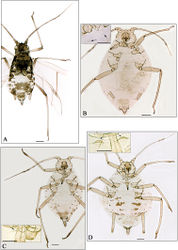Aphidura graeca
| Notice: | This page is derived from the original publication listed below, whose author(s) should always be credited. Further contributors may edit and improve the content of this page and, consequently, need to be credited as well (see page history). Any assessment of factual correctness requires a careful review of the original article as well as of subsequent contributions.
If you are uncertain whether your planned contribution is correct or not, we suggest that you use the associated discussion page instead of editing the page directly. This page should be cited as follows (rationale):
Citation formats to copy and paste
BibTeX: @article{Nieto2013ZooKeys318, RIS/ Endnote: TY - JOUR Wikipedia/ Citizendium: <ref name="Nieto2013ZooKeys318">{{Citation See also the citation download page at the journal. |
Ordo: Hemiptera
Familia: Aphididae
Genus: Aphidura
Name
Aphidura graeca Nieto Nafría & Mier Durante & Remaudière, 2013 sp. n. – Wikispecies link – ZooBank link – Pensoft Profile
Description
Apterous viviparous female (Fig. 5C). Colour in life unknown. Head pale yellow. Antennal segment I-IV and proximal half of V as pale as cephalic dorsum, distal part of V and VI yellow brown. Dorsum of thorax and abdomen membranous and pale, with yellowish brown spiracular and brown intersegmental sclerites. Mesosternal mammariform processes low, rugose and pale. Siphunculi gently and asymmetrically swollen, rugose and more-or-less pigmented like tibiae. Cauda tongue-shaped with broad apex, pigmented like siphunculi. Anal and genital plates as pale as cauda. Metric and meristic features in Table 4.
Types
Holotype: Apterous viviparous female, on Gypsophila sp., Veria [road to Kastania] (Imanthia), Greece, 18-VI-1964, G. Remaudière leg. (sample 03026).
Etymology
The specific name of the new species is an adjective that means inhabitant of Greece, in feminine.
Discussion
Aphidura graeca sp. n. lives on Gypsophila, as does Aphidura gypsophilae, and also Aphidura pannonica, which has been above recorded on this plant-genus for first time. The distinctive features of Aphidura graeca are summarized in the identification key to apterae of Aphidura in the general discussion and in the following modification to the key to aphids on Gypsophila (Blackman and Eastop 2006[1]), to include Aphidura graeca and Aphidura pannonica, and also Aphidura naimanica and Aphidura togaica, which have recently been described (Kadyrbekov 2013[2]):
Original Description
- Nieto Nafría, J; Mier Durante, M; Remaudière, G; 2013: The genus Aphidura (Hemiptera, Aphididae) in the collection of the Muséum national d’Histoire naturelle of Paris, with six new species ZooKeys, 318: 1-33. doi
Other References
- ↑ Blackman R, Eastop V (2006) Aphids on the World’s herbaceous plants and shrubs. Volume 1 Host Lists. Volume 2 The Aphids. John Wiley and Sons Ltd. Chichester, United Kingdom, 8+1439 pp. Actualized 2013: Aphids on the World’s plants. An online identification and informative guide. http://www.aphidsonworldsplants.info [accessed April 2013]
- ↑ Kadyrbekov R (2013) Materiali po sistematike tlei roda Aphidura Hille Ris Lambers, 1956 (Homoptera, Aphididae). Zoologicheskii Zhurnal 92 (1): 34-49. doi: 10.7868/S0044513413010078
Images
|
